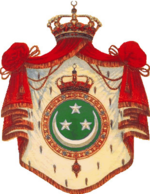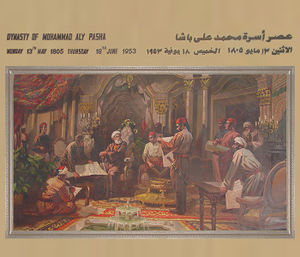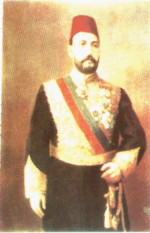Muhammad Ali Dynasty
 |
|
| Country | Egypt and Sudan |
|---|---|
| Titles | Wāli, self-declared as Khedive (1805-1867) Khedive officially recognized (1867-1914) Sultan (1914-1922) King (1922-1953) |
| Founder | Muhammad Ali Pasha |
| Final sovereign | Fuad II |
| Current head | Fuad II |
| Founding | 1805: Muhammad Ali's consolidation of power |
| Deposition | 1953: Abolition of monarchy following Egyptian Revolution of 1952 |
| Ethnicity | Egyptian of Albanian-Macedonian descent |
The Muhammad Ali Dynasty (Arabic: أسرة محمد علي Usrat Muhammad 'Ali) was the ruling dynasty of Egypt, the Levant, Hijaz, and Sudan from the 19th to the mid-20th Century. It is named after its progenitor, Muhammad Ali Pasha, regarded as the founder of modern Egypt. It was also more formally known as the Alawiyya Dynasty (Arabic: الأسرة العلوية al-Usra al-'Alawiyya), although it should not be confused with the ruling Alawiyya Dynasty of Morocco, to which it has no relation. Because a majority of the rulers from this dynasty bore the title Khedive, it was often referred to by contemporaries as the 'Khedival Dynasty'.
Contents |
Introduction
Muhammad Ali was an Albanian (His grandfather on the direct male line was a Kurd) commander of the Ottoman army that was sent to drive Napoleon's forces out of Egypt, but upon the French withdrawal, seized power himself and forced the Ottoman Sultan Mahmud II to recognize him as Wāli, or Governor (Arabic: والي) of Egypt in 1805.
Muhammad Ali transformed Egypt into a regional power which he saw as the natural successor to the decaying Ottoman Empire. He summed up his vision for Egypt in this way:
"I am well aware that the (Ottoman) Empire is heading by the day toward destruction...On her ruins I will build a vast kingdom...up to the Euphrates and the Tigris."

At the height of his power, Muhammad Ali and his son Ibrahim Pasha's military strength did indeed threaten the very existence of the Ottoman Empire as he sought to supplant the Osman Dynasty with his own. Ultimately, the intervention of the Great Powers prevented Egyptian forces from marching on Constantinople, and henceforth, his dynasty's rule would be limited to Africa, and Sinai. Muhammad Ali had conquered Sudan in the first half of his reign and Egyptian control would be consolidated and expanded under his successors, most notably Ibrahim Pasha's son Ismai'l I.
Khedivate and British Occupation
Though Muhammad Ali and his descendants used the title of Khedive in preference to the lesser Wāli, this was not recognized by the Ottoman Porte until 1867 when Sultan Abdul-Aziz officially sanctioned its use by Isma'il Pasha and his successors. In contrast to his grandfather's policy of war against the Porte, Ismai'l sought to strengthen the position of Egypt and Sudan and his dynasty using less confrontational means, and through a mixture of flattery and bribery, Ismai'l secured official Ottoman recognition of Egypt and Sudan's virtual independence. This freedom was severely undermined in 1879 when the Sultan colluded with the Great Powers to depose Ismai'l in favor of his son Tewfik. Three years later, Egypt and Sudan's freedom became little more than symbolic when the United Kingdom invaded and occupied the country, ostensibly to support Khedive Tewfik against his opponents in Ahmed Orabi's nationalist government. While the Khedive would continue to rule over Egypt and Sudan in name, in reality, ultimate power resided with the British High Commissioner.

In defiance of the Egyptians, the British proclaimed Sudan to be an Anglo-Egyptian Condominium, a territory under joint British and Egyptian rule rather than an integral part of Egypt. This was continually rejected by Egyptians, both in government and in the public at large, who insisted on the "unity of the Nile Valley", and would remain an issue of controversy and enmity between Egypt and Britain until Sudan's independence in 1956.
Sultanate and Kingdom
In 1914, Khedive Abbas II sided with the Ottoman Empire which had joined the Central Powers in the First World War, and was promptly deposed by the British in favor of his uncle Hussein Kamel. The legal fiction of Ottoman sovereignty over Egypt and Sudan, which had for all intents and purposes ended in 1805, was officially terminated, Hussein Kamel was declared Sultan of Egypt and Sudan, and the country became a British Protectorate. With nationalist sentiment rising, as evidenced by the Revolution of 1919, Britain formally recognized Egyptian independence in 1922, and Hussein Kamel's successor, Sultan Fuad I, substituted the title of King for Sultan. However, British occupation and interference in Egyptian and Sudanese affairs persisted. Of particular concern to Egypt was Britain's continual efforts to divest Egypt of all control in Sudan. To both the King and the nationalist movement, this was intolerable, and the Egyptian Government made a point of stressing that Fuad and his son King Farouk I were "King of Egypt and Sudan".

Dissolution
The reign of Farouk was characterized by ever increasing nationalist discontent over the British occupation, royal corruption and incompetence, and the disastrous 1948 Arab-Israeli War. All these factors served to terminally undermine Farouk's position and paved the way for the Revolution of 1952. Farouk was forced to abdicate in favor of his infant son Ahmed-Fuad who became King Fuad II, while administration of the country passed to the Free Officers Movement under Muhammad Naguib and Gamal Abdel Nasser. The infant king's reign lasted less than a year and on June 18 1953, the revolutionaries abolished the monarchy and declared Egypt a republic, ending a century and a half of the Muhammad Ali Dynasty's rule.
Reigning members of the Muhammad Ali Dynasty (1805-1953)
Wālis, self-declared as Khedives (1805-1867)
- Muhammad Ali (9 July 1805-1 September 1848)
- Ibrahim (reigned as Wāli briefly during his father's incapacity) (1 September 1848 - 10 November 1848)
- Abbas I (10 November 1848 - 13 July 1854)
- Sa‘id I (13 July 1854 - 18 January 1863)
- Ismai'l I (18 January 1863 - 8 June 1867)
Khedives (1867-1914)
- Ismai'l I (8 June 1867 - 26 June 1879)
- Tewfik I (26 June 1879 - 7 January 1892)
- Abbas II (8 January 1892 - 19 December 1914)
Sultans (1914-1922)
- Hussein Kamel (19 December 1914 - 9 October 1917)
- Fuad I (9 October 1917 - 16 March 1922)
Kings (1922-1953)
- Fuad I (16 March 1922 - 28 April 1936)
- Farouk I (28 April 1936 - 26 July 1952)
- Prince Muhammad Ali Tewfik (Chairman Council of Regency during Farouk I's minority) (28 April 1936 - 29 July 1937)
- Fuad II (26 July 1952 - 18 June 1953)
- Prince Muhammad Abdul Moneim (Chairman Council of Regency during Fuad II's minority) (26 July 1952 - 18 June 1953)
Non ruling members
| Egyptian Royal Family |

|
- Prince Mustafa Fazl Pasha
- Prince Mohammed Ali Tewfik
- Prince Muhammad Abdul Moneim
- Princess Fawzia Fuad
- Muhammad Ali, Prince of Said
- Narriman Sadek
- Nazli Sabri
- Mahmud Dramali Pasha
See also
- Muhammad Ali Dynasty family tree
- List of monarchs of the Muhammad Ali Dynasty
- History of Egypt under the Muhammad Ali dynasty
- History of Sudan under Muhammad Ali and his successors
- List of Sunni Muslim dynasties
Bibliography
- Hassan, H. (2000). In the House of Muhammad Ali: A Family Album, 1805-1952. American University in Cairo Press. ISBN 9789774245541. OCLC 45016821
External links
- "The Royal House of Mehmet Ali". http://www.geocities.com/hazemsakr/royal/index.html. Retrieved 2008-08-19.
- "Family tree of the House of Mohammed Aly". http://www.egy.com/P/royal/royaltree.html. Retrieved 2008-08-19.
- "The Royal Order of the Crown of Egypt" (in German). http://www.ordenskreuz.com/egypt.html. Retrieved 2008-08-19.
|
|||||||||||||||||||||